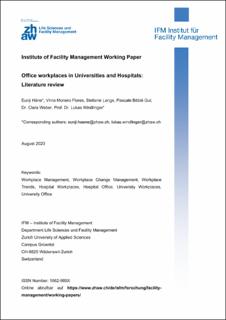Please use this identifier to cite or link to this item:
https://doi.org/10.21256/zhaw-20372Full metadata record
| DC Field | Value | Language |
|---|---|---|
| dc.contributor.author | Häne, Eunji | - |
| dc.contributor.author | Monero Flores, Virna | - |
| dc.contributor.author | Lange, Stefanie | - |
| dc.contributor.author | Bébié Gut, Pascale | - |
| dc.contributor.author | Weber, Clara | - |
| dc.contributor.author | Windlinger Inversini, Lukas | - |
| dc.date.accessioned | 2020-08-24T07:57:45Z | - |
| dc.date.available | 2020-08-24T07:57:45Z | - |
| dc.date.issued | 2020-08 | - |
| dc.identifier.issn | 1662-985X | de_CH |
| dc.identifier.uri | https://digitalcollection.zhaw.ch/handle/11475/20372 | - |
| dc.description.abstract | Compared to the rapidly developing commercial offices, office workplaces in universities and hospitals have changed only slightly. However, demands for new office workplaces in universities and hospitals are growing due to changed work processes and communication, changed organizational structures, new technologies, increased cost pressure, and the requirements of a modern knowledge society. This working paper reviews drivers and barriers of new ways of working in universities’ and hospitals’ office workplaces. To identify the latest drivers and barriers, this working paper reviews not only academic papers but also industry reports. This literature review determines six drivers of new academic workplaces: New way of working; new methods of teaching and communicating with students; cost pressure and need for space management; generation shift; internationalization; sustainable development and carbon reduction commitments. The literature review also addresses functional, cultural, hierarchical, and emotional reasons for resistance to introducing new academic workplaces. Next, this literature review identifies four drivers of new hospital office workplaces: Shortage of healthcare workforce; development of technologies; constant pressure and need for space management; need for diverse work settings. Besides, the literature review addresses barriers of new office workplaces in hospitals: change-reluctant organizational culture; clear hierarchical organizational structure; rapid change in IT; high perceived risk of first-time application of new office concept; cultural change; and financial restrictions. These findings suggested that Activity-Based Working (ABW) can be appropriate for office workplaces in universities and hospitals since ABW is acknowledged by increasing staff interaction; providing quiet places for solo-concentrated work; improving staff health and well-being; reducing space cost, and flexibility to change. Overall, this working paper emphasizes the need for new ways of working in universities’ and hospitals’ office workplaces and showed that barriers and resistance to introducing new office workspace should not be overlooked. | de_CH |
| dc.format.extent | 31 | de_CH |
| dc.language.iso | en | de_CH |
| dc.publisher | ZHAW Zürcher Hochschule für Angewandte Wissenschaften | de_CH |
| dc.rights | Licence according to publishing contract | de_CH |
| dc.subject | Workplace management | de_CH |
| dc.subject | Workplace change management | de_CH |
| dc.subject | Workplace trends | de_CH |
| dc.subject | Hospital office | de_CH |
| dc.subject | University workplaces | de_CH |
| dc.subject | University office | de_CH |
| dc.subject.ddc | 331: Arbeitsökonomie | de_CH |
| dc.title | Office workplaces in universities and hospitals : literature review | de_CH |
| dc.type | Working Paper – Gutachten – Studie | de_CH |
| dcterms.type | Text | de_CH |
| zhaw.departement | Life Sciences und Facility Management | de_CH |
| zhaw.organisationalunit | Institut für Facility Management (IFM) | de_CH |
| zhaw.publisher.place | Wädenswil | de_CH |
| dc.identifier.doi | 10.21256/zhaw-20372 | - |
| zhaw.funding.eu | No | de_CH |
| zhaw.originated.zhaw | Yes | de_CH |
| zhaw.webfeed | Workplace Management | de_CH |
| zhaw.author.additional | No | de_CH |
| zhaw.display.portrait | Yes | de_CH |
| Appears in collections: | Publikationen Life Sciences und Facility Management | |
Files in This Item:
| File | Description | Size | Format | |
|---|---|---|---|---|
| 2020_Haene-etal_Office-workplaces-in-universities-and-hospitals.pdf | 514.18 kB | Adobe PDF |  View/Open |
Show simple item record
Häne, E., Monero Flores, V., Lange, S., Bébié Gut, P., Weber, C., & Windlinger Inversini, L. (2020). Office workplaces in universities and hospitals : literature review. ZHAW Zürcher Hochschule für Angewandte Wissenschaften. https://doi.org/10.21256/zhaw-20372
Häne, E. et al. (2020) Office workplaces in universities and hospitals : literature review. Wädenswil: ZHAW Zürcher Hochschule für Angewandte Wissenschaften. Available at: https://doi.org/10.21256/zhaw-20372.
E. Häne, V. Monero Flores, S. Lange, P. Bébié Gut, C. Weber, and L. Windlinger Inversini, “Office workplaces in universities and hospitals : literature review,” ZHAW Zürcher Hochschule für Angewandte Wissenschaften, Wädenswil, Aug. 2020. doi: 10.21256/zhaw-20372.
HÄNE, Eunji, Virna MONERO FLORES, Stefanie LANGE, Pascale BÉBIÉ GUT, Clara WEBER und Lukas WINDLINGER INVERSINI, 2020. Office workplaces in universities and hospitals : literature review. Wädenswil: ZHAW Zürcher Hochschule für Angewandte Wissenschaften
Häne, Eunji, Virna Monero Flores, Stefanie Lange, Pascale Bébié Gut, Clara Weber, and Lukas Windlinger Inversini. 2020. “Office Workplaces in Universities and Hospitals : Literature Review.” Wädenswil: ZHAW Zürcher Hochschule für Angewandte Wissenschaften. https://doi.org/10.21256/zhaw-20372.
Häne, Eunji, et al. Office Workplaces in Universities and Hospitals : Literature Review. ZHAW Zürcher Hochschule für Angewandte Wissenschaften, Aug. 2020, https://doi.org/10.21256/zhaw-20372.
Items in DSpace are protected by copyright, with all rights reserved, unless otherwise indicated.